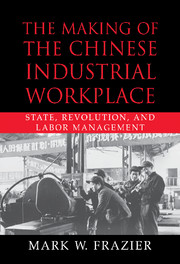Book contents
- Frontmatter
- Contents
- List of Tables
- List of Acronyms
- Preface
- 1 Introduction
- 2 Labor Management and Its Opponents, 1927–1937
- 3 Welfare and Wages in Wartime
- 4 Takeover Policies and Labor Politics, 1949–1952
- 5 Adjusting to the Command Economy
- 6 Enterprise Perspectives on the Command Economy
- 7 The Rise of “Party Committee Factories”
- 8 Conclusion
- Archives Consulted
- Bibliography
- Index
2 - Labor Management and Its Opponents, 1927–1937
Published online by Cambridge University Press: 15 December 2009
- Frontmatter
- Contents
- List of Tables
- List of Acronyms
- Preface
- 1 Introduction
- 2 Labor Management and Its Opponents, 1927–1937
- 3 Welfare and Wages in Wartime
- 4 Takeover Policies and Labor Politics, 1949–1952
- 5 Adjusting to the Command Economy
- 6 Enterprise Perspectives on the Command Economy
- 7 The Rise of “Party Committee Factories”
- 8 Conclusion
- Archives Consulted
- Bibliography
- Index
Summary
In the spring of 1933, a group of researchers from the China Economic Statistics Institute (CESI), with the backing of the Nationalist government, set out to conduct China's first comprehensive industrial census. The motivation for the census, as laid out in the preface of the eventual report published in 1937, was explicit: accurate industrial statistics were an indispensable element of national defense. The author of the preface noted that during the European War (World War I), the governments of several Western nations including the United States had established wartime industrial management boards that among other things conducted national censuses to measure industrial capacity. The census report's publication in 1937 ironically foreshadowed China's own wartime mobilization against Japan, and the study represents one part of the Nationalist government's broader state-building effort in the 1930s.
The census-taking process and the obstacles that the CESI researchers encountered in their 1933–4 survey census reveals something of the limits of central government power in relation to local officialdom. For example, Shanghai authorities refused to grant permission to the census takers to carry out their survey, a stance that posed obvious problems for the research effort because a large percentage of China's industrial base was located there. According to the author of the census report, the Shanghai municipal government's Bureau of Industry (gongbu ju) refused to grant permission for the census to be taken within the city's factories on the grounds that CESI was a national, not a local government entity.
- Type
- Chapter
- Information
- The Making of the Chinese Industrial WorkplaceState, Revolution, and Labor Management, pp. 23 - 59Publisher: Cambridge University PressPrint publication year: 2002
- 1
- Cited by



